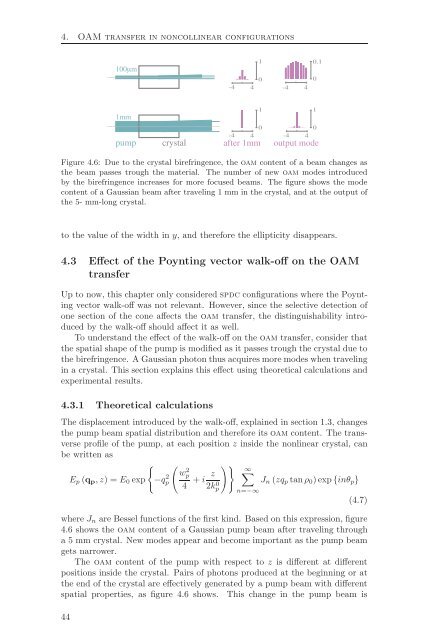Spatial Characterization Of Two-Photon States - GAP-Optique
Spatial Characterization Of Two-Photon States - GAP-Optique
Spatial Characterization Of Two-Photon States - GAP-Optique
Create successful ePaper yourself
Turn your PDF publications into a flip-book with our unique Google optimized e-Paper software.
4. OAM transfer in noncollinear configurations<br />
100µ m<br />
1mm<br />
pump crystal<br />
-4 4<br />
-4 4<br />
1<br />
0<br />
1<br />
0<br />
after 1mm<br />
-4 4<br />
-4 4<br />
0.1<br />
0<br />
1<br />
0<br />
output mode<br />
Figure 4.6: Due to the crystal birefringence, the oam content of a beam changes as<br />
the beam passes trough the material. The number of new oam modes introduced<br />
by the birefringence increases for more focused beams. The figure shows the mode<br />
content of a Gaussian beam after traveling 1 mm in the crystal, and at the output of<br />
the 5- mm-long crystal.<br />
to the value of the width in y, and therefore the ellipticity disappears.<br />
4.3 Effect of the Poynting vector walk-off on the OAM<br />
transfer<br />
Up to now, this chapter only considered spdc configurations where the Poynting<br />
vector walk-off was not relevant. However, since the selective detection of<br />
one section of the cone affects the oam transfer, the distinguishability introduced<br />
by the walk-off should affect it as well.<br />
To understand the effect of the walk-off on the oam transfer, consider that<br />
the spatial shape of the pump is modified as it passes trough the crystal due to<br />
the birefringence. A Gaussian photon thus acquires more modes when traveling<br />
in a crystal. This section explains this effect using theoretical calculations and<br />
experimental results.<br />
4.3.1 Theoretical calculations<br />
The displacement introduced by the walk-off, explained in section 1.3, changes<br />
the pump beam spatial distribution and therefore its oam content. The transverse<br />
profile of the pump, at each position z inside the nonlinear crystal, can<br />
be written as<br />
Ep (qp,z)=E0 exp<br />
<br />
−q 2 p<br />
w 2 p<br />
4<br />
z<br />
+ i<br />
2k0 <br />
∞<br />
Jn (zqp tan ρ0) exp {inθp}<br />
p n=−∞<br />
(4.7)<br />
where Jn are Bessel functions of the first kind. Based on this expression, figure<br />
4.6 shows the oam content of a Gaussian pump beam after traveling through<br />
a 5 mm crystal. New modes appear and become important as the pump beam<br />
gets narrower.<br />
The oam content of the pump with respect to z is different at different<br />
positions inside the crystal. Pairs of photons produced at the beginning or at<br />
the end of the crystal are effectively generated by a pump beam with different<br />
spatial properties, as figure 4.6 shows. This change in the pump beam is<br />
44



